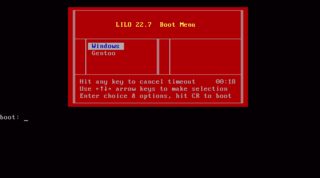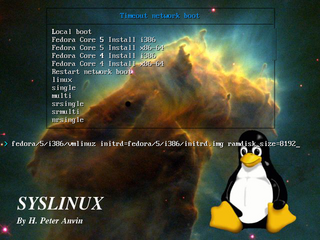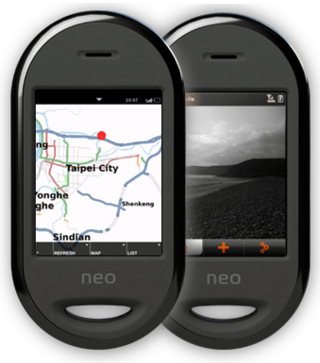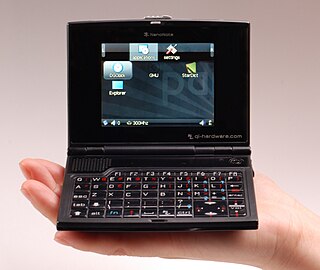Related Research Articles

LILO is a boot loader for Linux and was the default boot loader for most Linux distributions in the years after the popularity of loadlin. Today, many distributions use GRUB as the default boot loader, but LILO and its variant ELILO are still in wide use. Further development of LILO was discontinued in December 2015 along with a request by Joachim Wiedorn for potential developers.

GNU GRUB is a boot loader package from the GNU Project. GRUB is the reference implementation of the Free Software Foundation's Multiboot Specification, which provides a user the choice to boot one of multiple operating systems installed on a computer or select a specific kernel configuration available on a particular operating system's partitions.

The Syslinux Project is a suite of five different boot loaders for starting up Linux distros on computers. It was primarily developed by H. Peter Anvin.
Linux Terminal Server Project (LTSP) is a free and open-source terminal server for Linux that allows many people to simultaneously use the same computer. Applications run on the server with a terminal known as a thin client handling input and output. Generally, terminals are low-powered, lack a hard disk and are quieter and more reliable than desktop computers because they do not have any moving parts.
Computer operating systems based on the Linux kernel are used in embedded systems such as consumer electronics, in-vehicle infotainment (IVI), networking equipment, machine control, industrial automation, navigation equipment, spacecraft flight software, and medical instruments in general.

Harald Welte, also known as LaForge, is a German programmer.
In Linux systems, initrd is a scheme for loading a temporary root file system into memory, to be used as part of the Linux startup process. initrd and initramfs refer to two different methods of achieving this. Both are commonly used to make preparations before the real root file system can be mounted.
loadlin is a Linux boot loader that runs under 16-bit real-mode DOS. It allows the Linux system to load and replace the running DOS without altering existing DOS system files.
In the context of free and open-source software, proprietary software only available as a binary executable is referred to as a blob or binary blob. The term usually refers to a device driver module loaded into the kernel of an open-source operating system, and is sometimes also applied to code running outside the kernel, such as system firmware images, microcode updates, or userland programs. The term blob was first used in database management systems to describe a collection of binary data stored as a single entity.

Kernel-based Virtual Machine (KVM) is a free and open-source virtualization module in the Linux kernel that allows the kernel to function as a hypervisor. It was merged into the mainline Linux kernel in version 2.6.20, which was released on February 5, 2007. KVM requires a processor with hardware virtualization extensions, such as Intel VT or AMD-V. KVM has also been ported to other operating systems such as FreeBSD and illumos in the form of loadable kernel modules.

Openmoko is a discontinued project to create a family of mobile phones that are open source, including the hardware specification, the operating system, and actual smartphone development implementation like the Neo 1973 and Neo FreeRunner. The whole project was sponsored by Openmoko Inc.
The Linux booting process involves multiple stages and is in many ways similar to the BSD and other Unix-style boot processes, from which it derives. Although the Linux booting process depends very much on the computer architecture, those architectures share similar stages and software components, including system startup, bootloader execution, loading and startup of a Linux kernel image, and execution of various startup scripts and daemons. Those are grouped into 4 steps: system startup, bootloader stage, kernel stage, and init process. When a Linux system is powered up or reset, its processor will execute a specific firmware/program for system initialization, such as Power-on self-test, invoking the reset vector to start a program at a known address in flash/ROM, then load the bootloader into RAM for later execution. In personal computer (PC), not only limited to Linux-distro PC, this firmware/program is called BIOS, which is stored in the mainboard. In embedded Linux system, this firmware/program is called boot ROM. After being loaded into RAM, bootloader will execute to load the second-stage bootloader. The second-stage bootloader will load the kernel image into memory, decompress and initialize it then pass control to this kernel image. Second-stage bootloader also performs several operation on the system such as system hardware check, mounting the root device, loading the necessary kernel modules, etc. Finally, the very first user-space process starts, and other high-level system initializations are performed.
dm-crypt is a transparent block device encryption subsystem in Linux kernel versions 2.6 and later and in DragonFly BSD. It is part of the device mapper (dm) infrastructure, and uses cryptographic routines from the kernel's Crypto API. Unlike its predecessor cryptoloop, dm-crypt was designed to support advanced modes of operation, such as XTS, LRW and ESSIV, in order to avoid watermarking attacks. In addition to that, dm-crypt addresses some reliability problems of cryptoloop.

OpenEZX was a project active from 2004 to 2008, which gathered information about the Linux based Motorola EZX phone platform.

SHR was a community-driven Linux distribution for smartphones which was based on OpenEmbedded, Xorg, and the freesmartphone.org (FSO) framework. Several different graphical toolkits were made available, such as GTK+ and Qt.
In Linux, and other Unix-like operating systems, the /boot/ directory holds files used in booting the operating system. The usage is standardized in the Filesystem Hierarchy Standard.

Qi Hardware is an organization which produces copyleft hardware and software, in an attempt to apply the Free Software Foundation's GNU GPL concept of copylefting software to the hardware layer by using the CC BY-SA license for schematics, bill of materials and PCB layout data. The project has been both a community of popular open hardware websites and a company, founded by Steve Mosher, Jon Phillips, Wolfgang Spraul and Yi Zhang, that makes hardware products. Formed from the now defunct Openmoko project, key members went on to form Qi Hardware Inc. and Sharism At Work Ltd. Thus far, the project has released the Ben Nanonote, the Milkymist One, and the Ben WPAN wireless project to create a copyleft wireless platform. The examples of Qi hardware projects are the Ben NanoNote pocket computer, Elphel 353 video camera and Milkymist One video synthesizer.
OpenWrt is an open-source project for embedded operating systems based on Linux, primarily used on embedded devices to route network traffic. The main components are Linux, util-linux, musl, and BusyBox. All components have been optimized to be small enough to fit into the limited storage and memory available in home routers.

The Ben NanoNote is a pocket computer using the Linux-based OpenWrt operating system. An open-source hardware device developed by Qi Hardware, it has been called possibly "the world's smallest Linux laptop for the traditional definition of the word.". In addition, the Ben NanoNote is noteworthy for being one of the few devices on the market running entirely on copyleft hardware.

The PinePhone is a smartphone developed by Hong Kong-based computer manufacturer Pine64, intended to allow the user to have full control over the device. Measures to ensure this are: running mainline Linux-based mobile operating systems, assembling the phone with screws, and simplifying the disassembly for repairs and upgrades. LTE, GPS, Wi-Fi, Bluetooth and both cameras can be physically switched off. The PinePhone ships with the Manjaro Linux operating system using the Plasma Mobile graphic interface, although other distributions can be installed by users.
References
- ↑ Yaghmou, Karim (April 22, 2003). Building Embedded Linux Systems. O'Reilly Media, Inc. pp. 249–252. ISBN 9780596516468 . Retrieved 2014-05-26.
- ↑ "LILO vs. GRUB [LWN.net]". lwn.net. Retrieved 2024-04-16.
- ↑ Almesberger, Werner (2000), "Booting linux: the history and the future", Proceedings of the Ottawa Linux Symposium
- ↑ Almesberger, Werner; and Lermen, Hans (2000), Using the initial RAM disk (initrd)
- ↑ Bert Hubert (2002). "Linux Advanced Routing & Traffic Control HOWTO". lartc.org. Retrieved 2014-05-26.
- ↑ Terrence O'Brien (2000-05-05). "Linux/ATM - State of Play". linuxdevcenter.com. Retrieved 2011-07-18.
- ↑ ohn Mahoney (2008-06-08). "OpenMoko Smartphone Doing the Full Open Monty, Releasing Chip Schematics For Building Your Own". gizmodo.com. Retrieved 2014-05-26.
- ↑ Terrence O'Brien (2011-06-17). "Qi-Hardware debuts free, open source wireless solution, not a threat to WiFi". engadget.com. Retrieved 2011-07-18.
- ↑ "Qi Hardware Releases Free Wireless Hardware". rejon.org. 2011-06-15. Archived from the original on 8 July 2011. Retrieved 2011-07-18.
- ↑ Jake (2011-06-16). "Phillips: Qi Hardware Releases Free Wireless Hardware". lwn.net. Retrieved 2011-07-18.
- ↑ Electronista Staff (2011-06-17). "Qi Hardware makes open-source wireless networking tech". electronista.com. Retrieved 2011-07-18.
- ↑ Fabricatorz Staff (2011-06-17). "Qi Hardware Releases First Batch of 6LoWPAN Wireless Devices". fabricatorz.com. Retrieved 2011-07-18.
- ↑ Julie Bresnick (2001-02-26). "2.4 kernel: Always on the go with contributor Werner Almesberger". linux.com. Retrieved 2014-05-26.